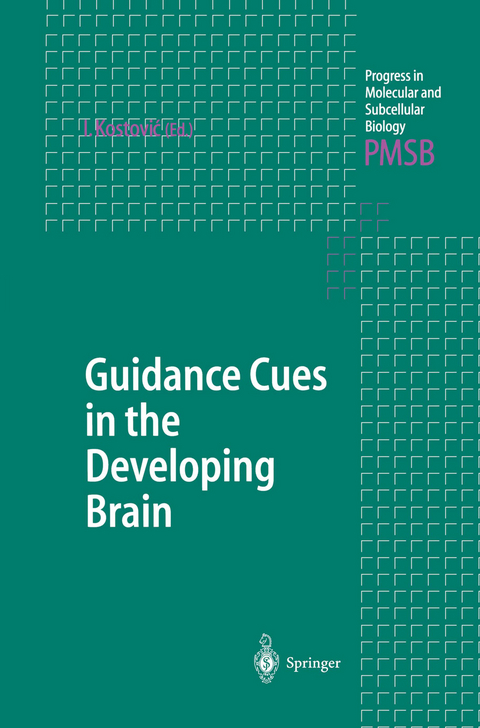
Guidance Cues in the Developing Brain
Springer Berlin (Verlag)
978-3-540-00117-1 (ISBN)
Many complex molecular interactions are involved in the development of the mammalian brain. Molecules serving as guidance cues for migratory cells, growing axons and for recognition of postsynaptic targets are a major topic for research because they are directly involved in the formation of neuronal circuits, thus creating the foundation for subsequent functional refinement through interactions with the environment. In addition, most guidance cue molecules are also involved in plasticity, damage repair and regeneration in the adult brain.
This volume reviews current knowledge on major classes of molecules involved in: guidance of growing axons; tau proteins involved in the establishment of axonal polarity, outgrowth and contact recognition; gangliosides and lectins involved in neuronal migration, neurite outgrowth and contact recognition; and myelin molecules that inhibit nerve regeneration.
Complex Patterns and Simple Architects: Molecular Guidance Cues for Developing Axonal Pathways in the Telencephalon.- 1 Introduction.- 2 The Four Major Classes of Axonal Guidance Cues Are Netrins, Semaphorins, Slits, and Ephrins.- 3 Axonal Guidance Cues Display a Characteristic Spatio-Temporal Pattern of Expression in Embryonic and Fetal Zones of the Telencephalon.- 4 Guidance Cues Have Complementary and/or Overlapping Roles in the Establishment of Specific Axonal Pathways.- 5 Early Genes Involved in Regionalization and Areal Specification of the Cerebral Cortex Can Regulate the Pattern of Expression of Axonal Guidance Cues.- 6 Discussion and Conclusions.- Phosphorylation Pattern of tau Associated with Distinct Changes of the Growth Cone Cytoskeleton.- 1 Historical Note.- 2 Neuronal Cytoskeleton and Microtubule-Associated Proteins.- 3 Neuronal Growth Cone Composition and Translocation.- 4 tau Gene Organization and Regulation.- 5 Structure of tau Proteins.- 6 Post-Translational Modifications of tau Proteins.- 7 Subcellular Localization of tau.- 8 The Role of tau Phosphorylation in Establishment of Axonal Polarity.- 9 The Role of tau Phosphorylation in Axonal Outgrowth and Morphology.- Developmental Expression and Possible Roles of Gangliosides in Brain Development.- 1 Introduction.- 2 Gangliosides and Brain Development.- 3 Possible Functional Roles of Gangliosides in the Developing Nervous System.- Mannose-Binding Lectins in Cerebrum Development.- 1 Introduction.- 2 Evidence for the Presence of Central Nervous System Mannose-Binding Lectins.- 3 Degradation of the Accumulated Axonal Mannose-Rich Glycoproteins in the Target Neurones.- 4 Evidence for the Presence of Mannose-Binding Lectins in the Cerebrum.- 5 The Cerebellar Soluble Lectins.- 6 The Lectin R1.- 7 Conclusionsand Perspective.- Functional Role of Gangliosides in Neuronal Motility.- 1 Introduction.- 2 Gangliosides and Cell Motility.- 3 Gangliosides and Glial Guided Radial Migration.- 4 Gangliosides and Tangential Migration.- 5 Gangliosides and Neurite Outgrowth.- 6 Conclusion and Perspectives.- Myelin Molecules Limiting Nervous System Plasticity.- 1 Introduction.- 2 Nogo.- 3 Myelin-Associated Glycoprotein.- 4 Chondroitin Sulfate Proteoglycans.- 5 Myelin Vaccine.- 6 Signaling Pathways in the Inhibition of Nerve Regeneration.- 7 Concluding Remarks.
| Erscheint lt. Verlag | 24.3.2003 |
|---|---|
| Reihe/Serie | Progress in Molecular and Subcellular Biology |
| Zusatzinfo | XII, 145 p. |
| Verlagsort | Berlin |
| Sprache | englisch |
| Maße | 155 x 235 mm |
| Gewicht | 422 g |
| Themenwelt | Medizin / Pharmazie ► Studium |
| Naturwissenschaften ► Biologie ► Genetik / Molekularbiologie | |
| Naturwissenschaften ► Biologie ► Humanbiologie | |
| Naturwissenschaften ► Biologie ► Zellbiologie | |
| Naturwissenschaften ► Biologie ► Zoologie | |
| Schlagworte | Axon Guidance • Axon Pathfinding • brain • Cells • Cytoskeleton • Development • Gehirn • genes • Growth cone • Migration • Morphology • Neurobiologie • Neuron • Neuronal Migration • Post-translational modification • Protein • proteins • Proteoglycans • Regeneration • Tempo • Translation |
| ISBN-10 | 3-540-00117-4 / 3540001174 |
| ISBN-13 | 978-3-540-00117-1 / 9783540001171 |
| Zustand | Neuware |
| Haben Sie eine Frage zum Produkt? |
aus dem Bereich


